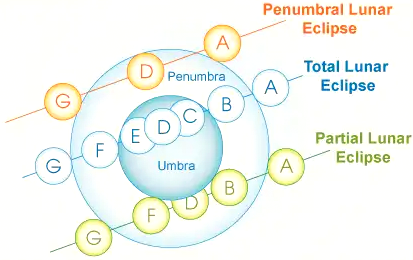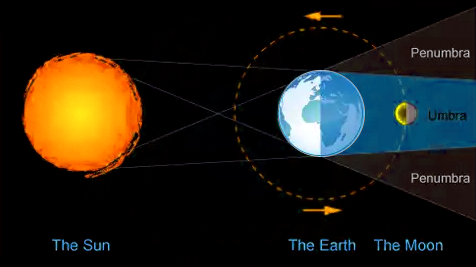
Total Lunar Eclipse
When the Moon enters the Earth's umbra, a Partial Lunar Eclipse and a Penumbral Lunar Eclipse will happen before and after a Total Lunar Eclipse.
| (A) | When the penumbra zones of the Earth and the Moon starts to contact |
| (B) | Partial Lunar Eclipse begins when the umbra zones of the Earth and the Moon contacts with each other |
| (C) | Total eclipse begins when the Moon enters the Earth's umbra zone completely |
| (D) | Middle of eclipse is when the centres of the Earth and the Moon are in the closest distance |
| (E) | Total eclipse comes to the end when the Moon starts to leave the umbra zone of the Earth |
| (F) | Moon leaves umbra zone of the Earth completely |
| (G) | Moon leaves penumbra zone of the Earth completely |
Partial Lunar Eclipse
When only a part of the moon enters the umbra of the Earth, a penumbral lunar eclipse will take place before and after the occurrence of a partial lunar eclipse.
| (A) | When the penumbra zones of the Earth and the Moon starts to contact |
| (B) | Partial Lunar Eclipse begins when the umbra zones of the Earth and the Moon contacts with each other |
| (D) | Middle of eclipse is when the centres of the Earth and the Moon are in the closest distance |
| (F) | Moon leaves umbra zone of the Earth completely |
| (G) | Moon leaves penumbra zone of the Earth completely |
Penumbral Lunar Eclipse
When the Moon enters only part of the Earth's shadow, the penumbra, the sunlight reflected by the surface of the Moon is less intense and the rim of the Moon is not totally obscured.
| (A) | When the penumbra zones of the Earth and the Moon starts to contact |
| (B) | Middle of eclipse is when the centres of the Earth and the Moon are in the closest distance |
| (C) | Moon leaves penumbra |

